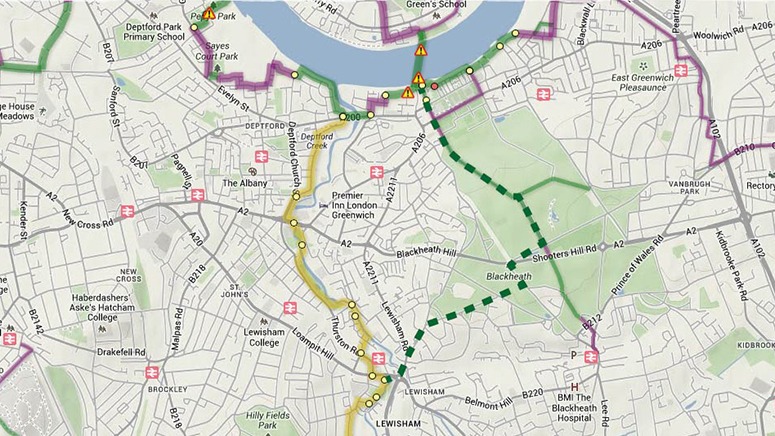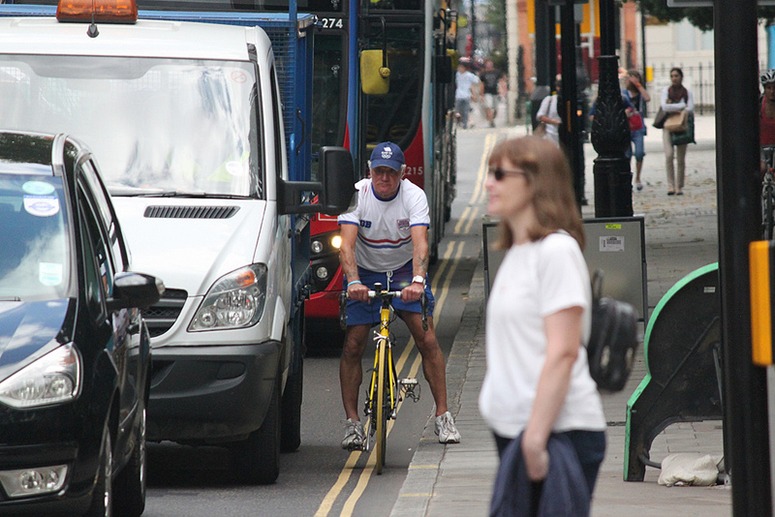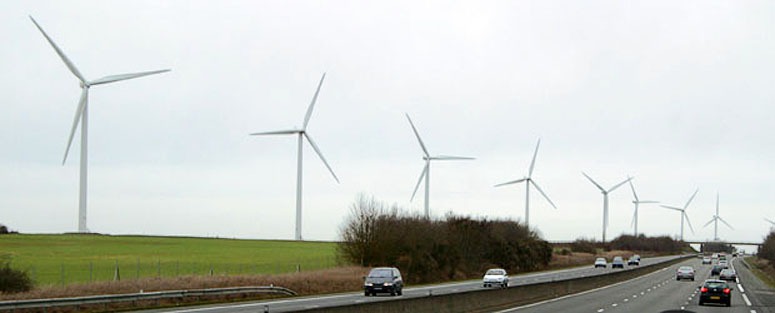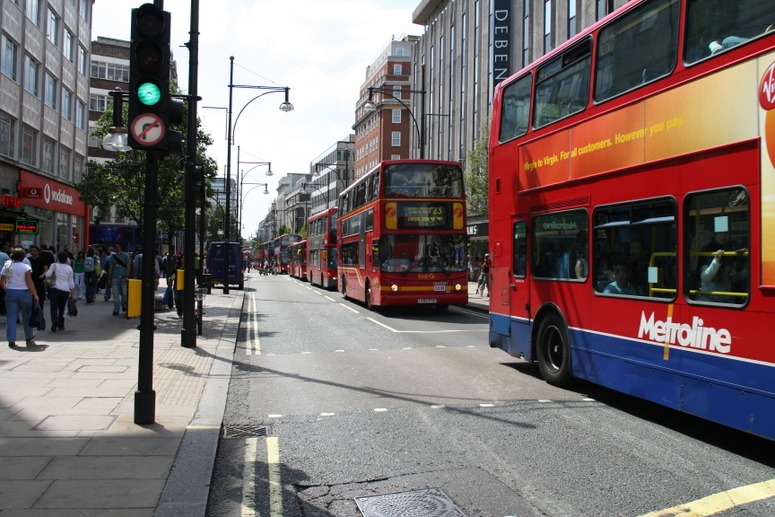 The traffic lanes in Oxford Street have been narrowing for 40 years, with the sidewalks being widened and regularly re-paved. Use of the street by private vehicles is restricted and use by diesel-powered commercial vehicles is increasing. Last week the Evening Standard reported that ‘Traders today said urgent action was needed to slash traffic levels after a report revealed Oxford Street has the highest levels of a toxic pollutant in the world. The mayor is facing demands to reduce the build-up of the “wall of buses” after a monitor installed by scientists showed high levels of nitrogen dioxide – linked with asthma and heart attacks.’
The traffic lanes in Oxford Street have been narrowing for 40 years, with the sidewalks being widened and regularly re-paved. Use of the street by private vehicles is restricted and use by diesel-powered commercial vehicles is increasing. Last week the Evening Standard reported that ‘Traders today said urgent action was needed to slash traffic levels after a report revealed Oxford Street has the highest levels of a toxic pollutant in the world. The mayor is facing demands to reduce the build-up of the “wall of buses” after a monitor installed by scientists showed high levels of nitrogen dioxide – linked with asthma and heart attacks.’
The solution should be ‘NO HALF MEASURES’. Creating a ‘good shopping landscape’ should be the 100% priority. This will require (1) pedestrian movement to be prioritized (2) electric vehicles only to be permitted (3) far more planting (4) the use of glazed canopies over sidewalks should be encouraged.
I am happy to point to Nanjing Road Shanghai 南京路 as an example of how Oxford Street should be managed.
The problem, of course, is what to do with the buses and taxis? My answer is that they should be progressively excluded from Central London, to be replaced by underground trains, small electric vehicles and bicycles. Taxis are likely to be electric powered before long – because a Chinese company is now making the black cabs and this is its plan. Buses carrying passengers on long-distance journeys should be excluded from the central zone. Travelers can use non-polluting vehicles to reach the fringe of the zone and then continue their journeys by other means. These policies are related to Colin Buchanan’s proposals for Traffic In Towns but modified in response to the increase in London’s population, the growth of cycling, the availability of electric vehicles, the need for fuel economy and a better understanding of the health risks arising from noxious pollution. The Wiki article on Oxford Street has attractive photographof the street in 1875 and its progressive debasement.
Category Archives: green transport
How to plan a cycling protest demo – the POP Pedal on Parliament 2014 event in Edinburgh
It is good to have
– scenic drama, with the route planned by a landscape architect
– emotional music, planned by a musical director and extending along the whole route
– a persuasive narrative, with speeches by children, activists and politicians
– good co-opration from the police
– jokes, fun and glamour
– good supporting information on a website, with facts, figures and international comparisons
And it’s good to reflect that ‘Power must be taken, it is never given’. (William Powell)
The 2013 London bicycle die-in was good on music and drama but not so good on speeches.
The 2014 POP Pedal On Parliament in Edinburgh was good in all respects.
Cycle Infrastructure Guide UK and the landscape architecture of the Waterlink Greenway
Here is a video of the Waterlink Way from Maritime Greenwich to Lewisham. It was ‘completed’ c 2009 and is categorised as a greenwway on the TfL Website. Its quality gets better south of Catford and I do not object to the signposting. But before calling it a greenway they should have either (1) marked it as a temporary, until it can be re-routed along Deptford Creek, or, (2) employed a landscape architect to create a temporary design (3) asked a local landscape architect (me!) to recommend an alternative route as pro bono work. I would have recommended the route shown by a green dotted line on excerpt from the Sustrans plan below. Greenwich Park is also shown on the title image at the start of the video.
The route through Greenwich Park and across Blackheath is beautiful and historic. It connects to what could and should be a cycle route on the east side of Lewisham Hill. A great advantage of making this a designated cycle track (shared with pedestrians) is that it would be used by commuters wishing to reach Lewisham Station and Lewisham High Street. It could also connect to local schools, giving mums, dads and kids safe routes to school – so that they do not have to take them by car. The ‘greenway’ shown on my video could not have these roles.
UK Cycling Policy and Landscape Architecture Grade Cycle Paths
Isn’t it amazing that a mere 2% trips in the UK are made by bike, compared with 14% in Germany and 30% in Holland? As everyone knows, Britain’s cycle paths, like its NHS and Black Cabs, are ‘the envy of the world’. Our famous Yellow Cycle Paths are designed to protect the jobs of highwaymen and create jobs for doctors. And what a great contribution they make. We hardly have to allocate any land or money to cycling and it makes a massive contribution to the workload of Accident and Emergency Departments throughout the land.
London is raising the percentage of its transport budget spent on cycling to 2%. This is great news for doctors and nurses. If it had been increased to 30%, heading for Dutch and Danish levels, there is a real danger that cycling would become safer and more popular. This would lead directly to fewer accidents, fewer strokes and fewer heart attacks. There is also a terrible risk that the salaries of landscape architects would exceed those of doctors, because of the great contribution to health and wellbeing made by Landscape Architecture Grade Cycle Paths. This could threaten the very liveliehood of thousands of health professionals. They would give up being highwaymen and sawbones to become landscape architects. What good would that do for the British Medical Association or the Institute of Civil Engineers? None! ‘Say No to Greening London’. Keep the two-wheeled blighters in their Narrow Yellow Lanes. Let them drip sweat, break bones and ooze blood for a thousand years.
London cycling image courtesy Tejvan
Wind turbines' landscape and financial impact in the UK
Big landowners have the easiest job getting planning permission for wind turbines, because the only people who live within sight are likely to be their tenants. Wind farm subsidies were about £1bn in 2012, though the rate of subsidy was cut by 10% this year. I drove past an ugly wind farm in Scotland this year, with 22 turbines dominating the landscape. The visual impact was grim, so I began to wonder about their financial impact. With the advantage of generous subsidies, Merryn Somerset Webb calculates that each turbine will yield the owner a profit of £200,000/year for 20 years. This amounts to £4m over the period, or £88m for the group of turbines. This lets the ‘generous’ company which developed the scheme give £1m to the local community over the 20 year period. A landowner who allows a turbine on his land can expect a rent of £1m over the period (£50,000/year). So why not follow the French example and locate the turbines on land beside motorways? This would keep the two sorts of ugliness together and remind motorists that they should be using electricity to power their vehicles. The airflow from vehicles might even be used, with special turbines, to generate electricity when there is no wind. Noise barriers could designed to deflect air currents to roadside turbines.
At present, visitors to the UK probably conclude that UK policy is to splat wind turbines anywhere in the landscape, providing only that no wealthy people, except landowners, live near them.
Cycle planning in London – landscape architects should help
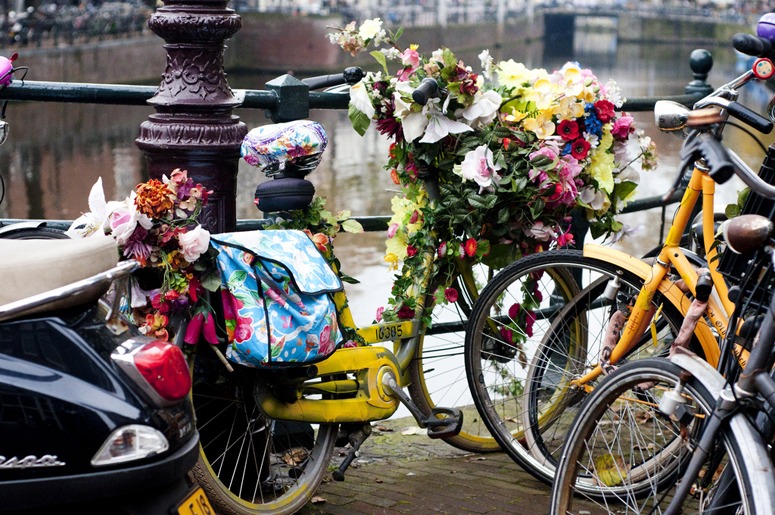 Great to see cycling as an issue in the election for a London Mayor and, since it is safer to judge politicians by what they do than by what they say, I will vote for the re-election of Boris Johnson. I have SEEN him cycling to work in London. Ken Livingstone says a bit about cycling but, during his years as Mayor, I SAW no significant improvements – and nor did I hear of him riding a bike.
Great to see cycling as an issue in the election for a London Mayor and, since it is safer to judge politicians by what they do than by what they say, I will vote for the re-election of Boris Johnson. I have SEEN him cycling to work in London. Ken Livingstone says a bit about cycling but, during his years as Mayor, I SAW no significant improvements – and nor did I hear of him riding a bike.
To ride with the election, the London Cycling Campaign is running a ‘Love London, Go Dutch’ campaign. The LCC points out that in the 1970s, cycling was not much more popular in Amsterdam than in London. Today, 3% of London journeys are made by bike (this includes 90% of my journeys!) and 47% of Amsterdam journeys are made by bike (figures from Evening Standard 26.4.2012). The cycle park at Zuid Station holds 2500 bikes and parking is free for the first 24 hours. TfL has a cycle park at London Bridge Station which holds 400 bikes and costs £1.50/day. I would like to see landscape architects taking an active role in London Cycle Planning and Design. Those ugly Barclays cycle ‘superhighways’ should be replaced by beautifully designed leafy and flowery routes. This will cost money – and the Landscape Institute should be a very-active campaigner for safe, convenient and enjoyable cycle lanes. It would not surprise me if 50% of landscape architects cycle to work in London – so they can be trusted to produce good designs.
Image courtesy MaWá

